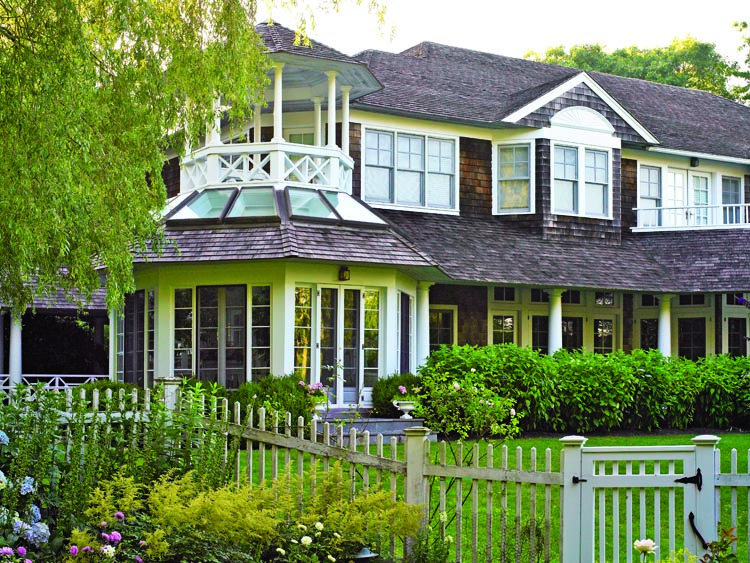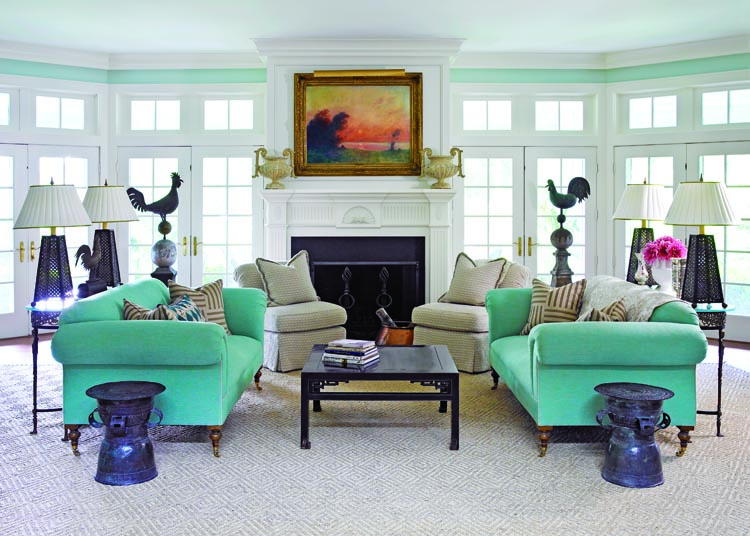Long Island Retreat
The high ceilings and light-filled space of the entry reflect the relaxed mood of the house. Of the ensemble by the doorway, the wife claims she had no set theme but that the elements “just kind of work.” “I would find things and pull them together,” she says. “For parties we light up the torcheres.” The clock face was from a bank in St. Louis. “We set the hands to the time of the birth of our daughter.” It hangs over an early seventeenth-century Spanish refectory table. The rooster and tea tins are from two pubs in England. About the transferware vase the wife notes that she is always looking for something interesting for flowers from the cutting garden.
The weekdays for this couple and teenage daughter are spent at their 1921 Manhattan townhouse. Each of its five floors is furnished with English and French period furniture and a stellar collection of sculpture and fine art, including works by Frederic Carl Frieseke (1874–1939), John White Alexander (1856–1915), and Richard Miller (1889–1963).
When the weekends roll around, the family, like so many of their fellow New Yorkers, head for Long Island. “We have been coming for years,” says the wife, “we love the location.” In 1995, when plans to buy a house in the Hamptons fell through, the couple, who originally had no intention of building a residence, found a piece of property on Georgica Pond and decided to erect a home. They hired local architect William “Bill” Reese (1943–2011) with whom they worked to design a residence in the traditional Hamptons vernacular. For the next two years, the family rented a house in East Hampton village during the weekends until their new home was ready.

- Rooms flow easily into one another, here extending from the living room into the dining room. The facing walls are bursting with spring colors that emanate from two paintings; on the left, Springtime in New Hampshire by Karl Albert Buehr (German, 1866–1952), one of three works by the artist in the couple’s collection; on the right, Robert Gwelo Goodman’s (South Africa, 1871–1939) Gathering Wildflowers, “a charming picture,” says the wife, an example of Goodman’s landscape style and his floral studies in one image. Guests at the dinner table sit in upholstered chairs; the husband and wife’s French walnut armchairs, circa 1860, retain their original cut velvet upholstery. The couple desired an old table, but period refectory tables are too narrow so they had this one made with old timbers. Of the folk portraits, the husband says, “I enjoy the primitive works. They are so different from paintings in our collection in the city.” He adds, “Because the artists are often unknown, you are buying solely based on what you like versus also considering a name.” While anonymity is the case for the central image, English, circa 1840, of a girl in a blue dress, the work on the left is by American artist Robert Street (1796–1865) and is signed “R. Street, 1850.”

- The nineteenth-century Welsh dresser is filled with period transferware and white ironstone. “When I buy ironstone,” says the wife, “I look for pitchers that have different shapes because I enjoy having a collection that is united by a theme but with variations within.” This material is readily available, creates a striking visual wall of color, and is accessible to any level of collector.
Though a summer retreat, the residence is a four-season house and is used year round. An ever-changing property, two years ago the couple, in conjunction with their interior decorator Wendy Duryea of WD Interiors in Connecticut, finished an expansion downward to excavate space beneath the house for a game room, wine cellar, and theater; and this past summer the couple worked with landscape architects to redesign the extensive flower gardens, which contain a large variety of roses, dahlias, hollyhocks, and peonies. Says the wife, “Our aim has been to create a home where everyone can feel comfortable, where our daughter can invite friends over for a movie, and where my husband and I can unwind with friends and family for a casual dinner.” She adds, “In the country I look forward to informal living and a feeling of escape from the city.”
The interior spaces of the residence are open and airy, with a color palette in tranquil greens, blues, and whites, reminiscent of the water. Says the husband, “When we designed the house we wanted the maximum number of windows to allow for a connection with the natural setting, pond, and nearby ocean, and to receive light from all angles. This presented a challenge so that we wouldn’t run out of wall space for the art.” The art to which he refers are landscapes and water scenes that hang in the living room. His wife reflects that the works are “perfect for a house not far from the beach, with images that are contemplative. She adds, “This is a house where we can play and mix it up.” The imagery of beaches, rocky coasts, sunsets, and fields of flowers, surround, soothe, and create a serene mood.

- “When we remodeled the study,” says the wife, “we had to redesign it around the apothecary.” A centerpiece of the room, the wife furthered the aesthetics of a pharmacy by including a period sign and glass bottles containing compounds used by druggists. Used as an office, the circa-1815 armchairs, in combination with the English partners’ desk provide an air of efficiency and formality that play off the apothecary materials.
With a masters in art history, the wife once thought she would be a curator. Though this did not end up happening, she notes, “I am delighted with the way things turned out because as I collect I have an appreciation of what I’m looking at.” Collecting for her is also visceral. “Sometimes I am shown a painting that a dealer thinks I will love,” she says, “but while the style may be lovely and it may be well done, if I don’t have an inner connection, then I don’t buy it. Art and objects call to you and you connect with the perfect thing.” Abby Taylor of Abby Taylor Fine Art has been instrumental in working with the couple to assemble their collection of post-impressionist works that hang in the living room.
In addition to the art, which includes folk portraits of children, the couple also collects samplers, silkwork, silhouettes, Staffordshire figures, and fun furnishings that add to the country atmosphere and provide a sculptural element, such as the various zinc and gilded roosters in many of the rooms. Bursts of color act as strategic accents throughout the house, as in the ironstone and blue-and-white wear that fills the Welsh cupboard in the dining room, or the Quimper in their sunlit breakfast room.

- The lower level of the house was excavated a few years ago to create a game room, wine vault, and media room. The wife designed the theater while her husband designed the media components. “My husband and I love watching Indie films such as The Eternal Sunshine of the Spotless Mind,” says the wife, “which was shot in part just down the road from us on a local beach. Foreign films are also a favorite; the cinematic tastes of our daughter and her friends run more to Will Ferrell.”

- The table and chairs in the wine vault are the perfect setting for tastings. Any time of day or night is the perfect time to spend on the porch, sitting in the set of circa-1915 Hayward Wakefield wicker, which retains its original paint; the drink stands are unusual to find. Alternatively, sitting by the pool is a delightful alternative, as is walking through the gardens.
“Collecting has been a labor of love,” says the husband. “When we first moved into the house we went to every antiques show we could find every weekend, not only here in the Hamptons but in Connecticut and New Hampshire.” “We were looking for things to put in the house,” notes the wife, “and before we knew it, a collection had evolved.” “It’s been a lot of fun,” adds the husband. “We have tried to have a different style here than in our Manhattan residence.” On the large purchases, whether for here or the city, they must both agree. “We buy as a couple,” they say. Adds the wife with a smile, “Except for when I win.” Laughing, her husband nods and says, “The secret of a good marriage is to have no opinion on anything.” In reality, though, it is a team effort.
This article was originally published in the Autumn/Winter 2012 issue of Antiques & Fine Art magazine, a digitized version of which is available at afamag.com. AFA is affiliated with Incollect.com







































